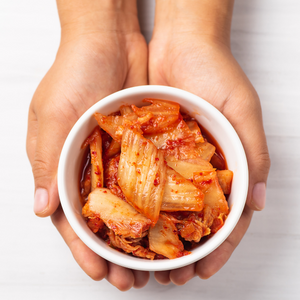
Vegan & Gluten Free Kimchi
Kimchi is a traditional Korean side dish of salted and fermented vegetables, such as napa cabbage and Korean radish. It's basically Korean sauerkraut.If you have chronic digestive problems like IBS, fermented foods may help as they enhance the digestive process and have a positive effect on the gut flora, thus reducing problematic digestive symptoms.
Equipment
- Large Mixing Bowl
- Gloves (Optional)
- 5-6 Large Empty CLEAN Jars
Ingredients
- 3 Medium heads of napa cabbage
- 1 Handful of sea salt or kosher salt
- Water Preferably distilled or filtered
- 1 Tbsp Garlic Grated
- 2 Thumbs of fresh ginger Grated
- 1 Tbsp Sugar
- 2 Tbsp Tamari
- 2 Tsp Kelp Powder
- 3 Tbsp Gochugaru Korean red pepper flakes
- 1 Lrg Pealed daikon radish (normal radishes will work too) Cut into matchsticks
- 4 Medium peeled carrots
- 4 Medium scallions Trimmed and cut into 1-inch pieces
Instructions
- Cut the cabbage lengthwise through and then crosswise into 2-inch-wide strips.
- Place the cabbage in a large bowl and sprinkle with the salt. Massage the salt into the cabbage until it starts to soften.
- Add enough water to cover the cabbage. Put a plate on top and weigh it down with something heavy. Let it stand for 2 hours.
- Rinse and drain the cabbage 3 times under cold water. Drain for 30 mins.
- Meanwhile prepare all other ingredients. After the cabbage has drained, mix everything thoroughly, work the paste into the vegetables until they are thoroughly coated.
- Pack the kimchi into jars. Press down on the kimchi until the brine rises to cover the vegetables, leaving at least 1 inch of space at the top. Seal the jar.
- Let them ferment for 1 to 5 days. Place jars on something to catch any overflow. Keep at cool room temperature, out of direct sunlight, for 1 to 5 days. It's normal to see bubbles inside the jar and brine may seep out.
- Check the kimchi once a day, opening the jar and pressing down on the vegetables with a clean spoon to keep them submerged under the brine and release gases produced during fermentation.
- When the kimchi tastes ripe enough for your liking, transfer the jar to the refrigerator. The cold will stop further fermentation.
- You may eat it right away, but it's best after another week or two.
Notes
- Only ever use clean utensils in you Kimchi!!
- Make sure your jars and lids are very clean
- Use salt that is free of iodine and anti-caking agents, which can inhibit fermentation.
- Kimchi can be refrigerated for up to a few months.